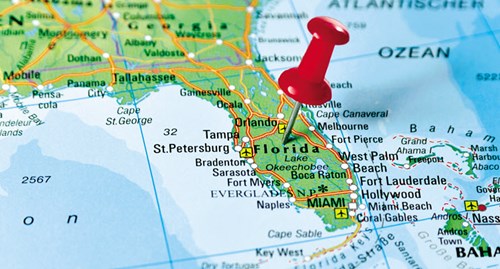
Graham Aistrop, an international mortgage broker based in Orlando, provides an insider’s guide to getting a loan in the US.
Thousands of overseas buyers from across the globe are obtaining finance to buy their holiday homes in Florida. To Europeans and Canadians, the US system appears dysfunctional and overly-complicated, with the transaction frequently being led by the lender not the purchaser’s completion (or closing) date. However, don’t be put off by the American system, be patient and you will qualify for an American mortgage easier than applying for a UK mortgage! The first point to note it that foreign nationals or FN (people who does not reside in the USA and visits for short periods e.g. holidays) are treated differently to ‘US citizens’ who might a permanent resident alien (Green Card holder), a lawful permanent resident (visa holder) or a US citizen. Some brokers will be equipped for dealing with FNs, and might be referred to as ‘FN brokers’. It’s a complex subject to cover but here are some pointers to get you in the right direction.
1. Find a good mortgage broker
Contact one at the earliest opportunity, certainly before you come to Florida to see a realtor (estate agent); they may need you to be pre-qualified before they will spend time taking you out to view properties. Contact a couple of mortgage brokers – but bear in mind that not all brokers are competent in foreign national mortgages. They should advise on what programmes (deals) are available and issue a mortgage pre-qualification letter at no charge. Ask for the terms of each mortgage programme so you are not taken by surprise, prior to closing, e.g. is there a prepayment penalty, what is the lifetime rate, can the rate go down as well as up, etc.
2. What are 'closing costs'?
Contact a couple of brokers for comparison fees ‘worksheets’. A worksheet is an initial document which itemises the typical closing costs for a Florida purchase. Closing costs (in the UK they are known as mortgage set-up fees and conveyancing costs) refer to charges and fees which are associated when a house purchase is finalised. Buyers closing costs can be divided into two main categories: 1) Costs associated with buying a home: lender’s charges, such as underwriting, origination, processing and document preparation fees; ‘closing’ costs: agent’s fees and title insurance premium. Plus ‘third party fees’ such as appraisal (valuation), credit report, and survey. 2) Costs associated with owning a home: property taxes (council tax), buildings insurance (also called hazard insurance) and homeowners association (HOA) dues. Most lenders will collect a portion of the borrower’s property taxes and buildings insurance at closing and hold them in an escrow account. The lender will then pay the property taxes in November and pay the insurance renewal when due, out of monies held in the borrower’s escrow account.
3. Deposit and rates?
The deposit is frequently 30 per cent with rates from 6.00 per cent. Some lenders reduce the rate with the more deposit you off er. Other lenders off er 25 per cent deposit but rates could be higher. Don’t believe what you read on the internet about interest rates and don’t be misled by some brokers over low rates. Those low rates are generally for US borrowers not overseas citizens.

4. Are all property types equal?
Most FN (foreign national) brokers can off er finance for all types of property, including condos, although the latter may attract a higher rate. Many lenders have a minimum of $100K mortgage amount, a couple may go down to $75K but, again, higher rates may apply.
5. Budget for deposit monies
You must factor in closing costs (see point 2, above) to any funds you have for a deposit. Work on around 4-5 per cent of the purchase price for closing costs and deduct that amount from the overall funds you have available.
6. Do the right thing: documents required
Originals are not required but US lenders are still strict on what is acceptable. Provide exactly what is asked for: bank statements – all pages, even if blank. You may think you are saving paper by sending one page of four but the US lender needs all four pages. Don’t send screen shots of any documents, they are not accepted, due to potential fraud. Scanned copies of all documents are required.
7. Sourcing and 'seasoning' of funds
To comply with US money-laundering and anti-terrorism regulations you must do the following: Sourcing: show the lender where any large deposits in your accounts have come from (not your salary). Seasoning: showing the lender that the money you are going to use towards the purchase has been in your bank for a certain period of time (e.g. 60 days). See Point 8 below.
8. Allow enough time for funds to arrive before completion
You need to open a US bank account prior to closing (completing). Some lenders require your funds to close to be in your US bank account 30 days before closing – called seasoning (a couple even want 60 days). This can be frustrating because you are being asked to transfer funds to close, before you know whether you have been approved for a US mortgage. Check details with your broker.
9. Moving funds to the USA
Use a foreign exchange company to wire any funds to the USA as they tend to off er higher exchange rates than most banks.
10. What is a title company?
Find out more: Graham Aistrop International Mortgage Advisor USA Tel: 1-407 486 1636 UK Tel : 0203 355 1123